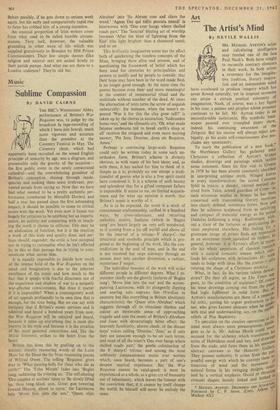Art
The Artist's Mind
By NEVILE WALLIS MR. MICHAEL AYRTON'S acute and calculating intelligence may remind one of the late, Paul Nash's. Both have sought to reconcile contrary elements in their work. In both artists a reverence for the imagina- tive tradition, literary inspira- tion and an independent mind have combined to produce imagery which has never flowed naturally, yet in inspired moments can attain a certain poetical solemnity of imagination. Nash, of course, was a key figure in his time, a painter and prophet whose presence continues to be felt. Mr. Ayrton today is an uncomfortable isolationist. His symbolic land- scapes painted over crumpled paper show, indeed, his continuing awareness of the Zeitgeist. But his reason will always reject am- biguity, as his acute self-consciousness also pre- cludes any spontaneity. To mark the publication of a new book,* the Matthiesen Gallery has gathered until Christmas a collection of Ayrton's bronze studies, drawings and paintings which invites some comment. Since his first visit to Greece in 1958 he has been almost constantly absorbed in interpreting antique myth. Winged Icarus in every transformation; the seated Cumzean Sybil in trance; a slender, visored sentinel de- rived from Talos, armed guardian of Crete—in such strenuous studies in bronze he has been concerned with transmuting literary emotions into clearly defined, vertebrate forms. Now and then he achieves sculptural form as satisfying and compact of muscular energy as his seated Dxdalus fashioning a wing: Rodinesque, with out a trace of the tortuous or gesticulating de- vices employed elsewhere. His feeling f°r. 3 grotesque image of power finds apt expression in an enormous trunk sustained on trotters. i" general, however. it is Ayrton's effort to recon- cile his whole apparatus of classical research with a natural romantic unease which over work ii loads his sculptures with intimations. Hi' w.rr tends to bulge with ideas like the cramm- gifts twisting the shape of a Christmas stock"' What, in fact, do his various talents dem° . strate? Do they all aspire, as The Times sug_ gests, to the condition of sculpture? Of coOrer his tense drawings coming out from the PaPall find logic fulfilment in solid form. But Aytron's manifestations are those of a researcio ful critic, putting his urgent preferences to,1,5 test, who gives keenest pleasure when he sPe'Ibie with zeal and understanding, say, on the Or reliefs of Pisa Baptistery.
he To speculate on the creative operations °
f tnl mind must always seem presumptuous.- -- „er gent as he is, Mr. Adrian Heath could neLis account for the alchemy which transforms.ougs notes of Hebridean sand and bay, and drawings the nude, and fuses them in his sens,11 abstract canvases at the Hanover Ga,ery. ur, They possess authority. It arises from the 13,„, poseful energy with which he conveys these .0-f timations of wind and the movement , natural forms in his swinging designs, statn01'.. ised by a vertical emphasis. Ovoid or thrud1.! crescent shapes, loosely linked and bathe IP vrtjltr; * MICHAEL AYRTON : DRAWINGS AND SCU''nd Mackay, 4 2 s b. .)y C.. P. Snow. (Cory. Adams 3
ambient light and atmosphere, are fluidly brushed in with nervous directional strokes. The freshness, the native lyrical overtones, withal the plenitude implied by a few blocks of luminous hue contrasted with some strong accent of colour or black—all goes to show the vital- ity of Heath's abstract composition when it receives a stimulus from natural sources. The exhibition signals an advance towards a figura- tion of his own.





























 Previous page
Previous page